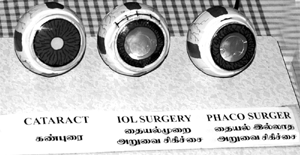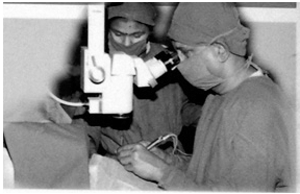Cataract
What is cataract?
The lens is normally clear and transparent. It allows light rays to pass through easily. The lens of the eye is essential for good vision. When a cataract develops, this lens becomes cloudy and opaque. Its ability to transmit light decreases with a gradual decrease in vision.
Types of cataract
- Age related (Senile) cataract is the most common type, comprising 80 percent of total cataracts. It usually occurs in patients above the age of 50.
- Congenital cataracts are rare. They can be caused by an infection of the mother that is transmitted to the fetus during pregnancy, or they may be hereditary.
- Traumatic cataracts are caused by injury to the eye. A hard blow, puncture, cut, intense heat or a chemical burn can damage the lens and lead to cataract formation.
- Secondary cataract: Eye diseases, such as glaucoma, iritis, eye tumors and diabetes may lead to cataracts.
- Drug – induced cataract: prolonged treatment with steroid drugs can sometimes cause cataract.
Symptoms of cataract
- Blurring or dimness of vision
- Feeling of a film over the eyes
- Sensitivity to light and glare
- Double vision
- Change in colour of pupil (Fig. 4.1)

Treatment options in cataract surgery
Removal of the clouded lens by surgery is the only treatment. Neither medication nor a change of glasses will improve vision.
A cataract operation is performed under local anesthesia or topical anesthesia. The clouded lens is removed and replaced by an intraocular lens (IOL).
In topical anesthesia, eye drops are put in to the eye and there is no need of an injection.
Before IOL surgery came into existence, glasses with high power (Aphakic Spectacles) were prescribed after cataract extractions.
It had a lot of disadvantages
- These glasses are heavy
- Images seen with these glasses appear larger than they normally are
- The field of vision is restricted
The implantation of an intraocular lens during cataract surgery averts the problems that would be created by wearing this type of glasses.
Types of surgeries
There are two types of surgeries
1. IOL implantation with sutures for closing the wound.
Local anesthesia is given and a 10mm incision is made in the eye. The clouded lens is removed and replaced by an IOL. The incision is then closed with sutures. The entire procedure takes only about 15 minutes.
Sutureless phacoemulsification surgery
In phaco with IOL surgery the cataract is broken in to small pieces with high energy sound waves and extracted from the eye through a 3 to 5mm incision. The wound seals itself and does not require sutures.
Small incision sutureless cataract surgery (SISCS)
SISCS with IOL, is an economical alternative to phaco, where a self-sealing tunnel, is made to do surgery. It has the same benefits in phaco with IOL, and is very suitable for developing countries (Fig.4.2).

Intra ocular lens implantation
An IOL is a tiny, transparent, convex lens made of polymethyl methacrylate (a harmless plastic material) which is inserted in the eye during surgery. Unlike contact lenses, an intraocular lens remains in the eye permanently and does not cause any irritation (Fig. 4.3)
Advantages of IOL
- Since the lens is placed inside the eye, the patient need not wear glasses for distant vision, but they have to wear glasses for reading
- Images are clear
- Full vision is obtained soon after surgery
Advantages of phaco
- Surgery can be done at early stage of cataract and the patient need not wait for the cataract to mature.
- Small incision
- No sutures
- No irritation
- No watering
- No need for suture removal
- Early return to work
- No need for hospital stay
- Better quality of vision and early recovery of good vision

Types of IOL
- Rigid IOL
- Foldable IOL
A rigid IOL requires more than a 5mm sized incision to place the IOL
A foldable IOL can be folded to half its size and inserted through a very small incision of about 2.8mm. The lens unfolds to its original size and shape after implantation into the eye (Fig. 4.4).

Advantages of foldable lens
- It can be implanted through a very small incision
- The incision heals faster with early visual recovery
- Induces less side effects like astigmatism, giving much better quality of vision

Posterior capsular opacity (PCO)
A few months or years after cataract surgery, a thin membrane may grow behind the IOL, on the posterior capsule, causing fall in vision. This is called PCO.
This membrane can easily be removed with a LASER treatment and good vision can be regained.
Role of counsellor in cataract
- To explain the disease condition and make the patient understand the need for surgery. In immature cataract, surgery is not an emergency and can be operated on at the patients’ convenience. But the patient should be told that phaco with IOL is possible only in the early stages of cataract. In the case of a mature or hypermature cataract, surgery has to be done at the earliest. Otherwise, the patient may have complications due to the cataract, with pain and redness, and making surgery very difficult.
The counsellor makes the patient realize the value of timely surgery. - The counsellor should understand the socioeconomic status and requirements of the patient and advice suitable surgery. For eg; a young driver - patient with immature cataract must be counselled for a phaco surgery with foldable lens. Similarly, if the doctor advises against phaco for a patient, she should make the patient understand that though phaco is not possible, a different surgery can be done with good visual results.
- The counsellor should patiently explain the importance of correctly applying post operative medication. She should stress on the importance of hygiene and washing hands before applying drops in the eye.
- The counsellor should ensure that the post operative followup schedule is strictly followed by the patient. Convenient follow up date for the patient can be fixed and the patient shall be encouraged to come earlier if he/she has pain, or defective vision.
Do’s and dont’s for patients after cataract surgery
Do’s
- a) Apply eyedrops at correct time properly
- b) Wash hands thoroughly before handling the drops
- c) Give adequate time between applying two medicines
- d) Maintain lid and personal hygiene
- e) Maintain a strict control of diabetes and hypertension
- f) Eat a regular, healthy diet
Don’t’s
- a) Do not rub the eye
- b) Do not drive
- c) Avoid dusty environment and smoke
- d) Do not use the medicines beyond the time the doctor has instructed you to use.
- e) Do not lift heavy weights
Frequently asked questions
1. Can cataract be treated with medicines or glasses? Why do I need surgery?
Removal of the clouded lens by surgery is the only treatment. Neither medication nor a change of glasses will improve vision.
2. Why do I need glasses after surgery?
The IOL is designed for distance vision. It cannot accommodate like a natural lens. Hence after surgery, glasses are needed for reading and near vision. Sometimes, glasses may be needed for distance vision also to correct any astigmatism after surgery.
3. Do I have to remove and clean the lens every day?
The IOL is implanted inside the eye. It can not be and need not be removed and cleaned every day like a contact lens.
4. How long is the life of the IOL? How many years guarantee does it have? Does the lens have to be changed after some times?
The IOL will stay in the eye life long. It need not be changed at all.
5. How soon can I resume normal work?
Though it depends on individual work requirements, generally after phaco with IOL surgery one can resume normal work after a week to two of rest.
6. Do I have to come for checkup after surgery? Why?
After surgery the eye surgeon will examine the eye for normal wound healing and possible post operative complications. The vision will be tested 1 month after surgery and the retina will be examined. Therefore, a check up after surgery is a must on the follow up date given.
7. Will the cataract grow again after surgery?
The cataract will not grow again, but a membrane may grow behind the IOL (PCO – posterior capsular opacification) after some time, which may decrease the vision.
8. Will I need surgery again for this membrane?
No, the membrane can be easily removed with a laser (ND: YAG capsulotomy) and does not require another surgery.
9. Is there a special intra ocular lens for cataract in diabetic patients?
Some types of IOLs (Silicon lens) should be avoided in diabetics. The preferred IOL in diabetics is a foldable IOL.
10. Is the surgery painful? Can be done without an injection?
Phaco with IOL surgery can be performed painlessly if done in early stages of cataract by applying only anesthetic drops. However if the cataract is mature, an injection will be put near the eye and the entire surgery done painlessly.
11. Is phaco with IOL a laser surgery?
Phaco with IOl surgery uses technique of Phacoemulsification in which high energy (ultrasound) sound waves are used to remove the cataract. It is not a laser.
12. Will I get 100% vision after cataract surgery?
Vision after cataract surgery also depends upon the functioning of the healthy retina and optic nerve. If every thing is normal, complete recovery of vision is possible after surgery. But in the presence of co-existing diseases like diabetic retinopathy or Age related macular diseases visual recovery may not be 100%.
Key points to remember
- Cataract is clouding of the normally clear lens causing decreased vision.
- There are different types of cataract while senile cataract is the most common.
- Surgery is the only treatment.
- Different types of surgeries are possible each of which involve removing the cataractuous and implanting an intraocular lens.
- The counsellor explains the need for surgery and the type of surgeries and IOLs, to the patient and helps him make a decision.
Student exercise
Write short answers
- How will you counsel the patient about the cataract surgery?
- What are the different types of cataract surgeries available?
- Mention the benefits of phaco with IOL surgery?
- How will you counsel the patient about the benefits of foldable lens?
- What is the counsellor’s role in giving cataract post operative instruction?
